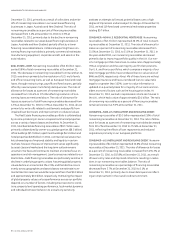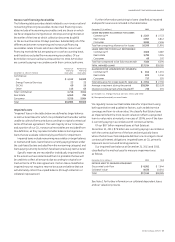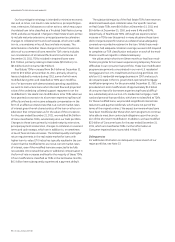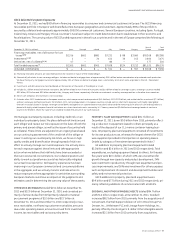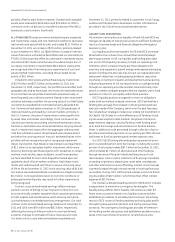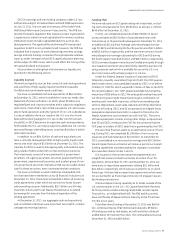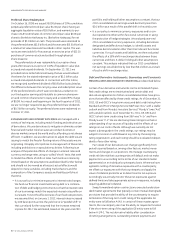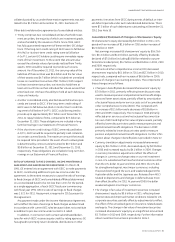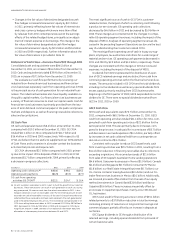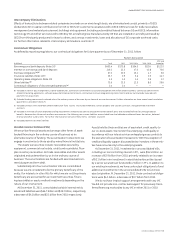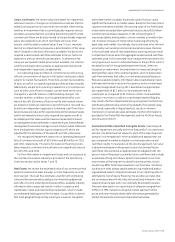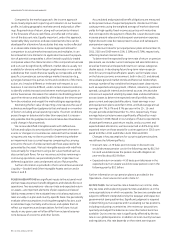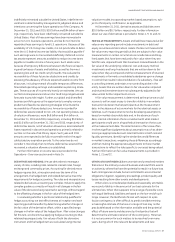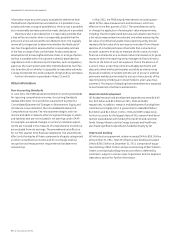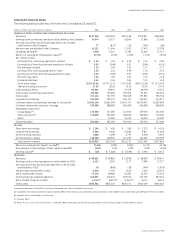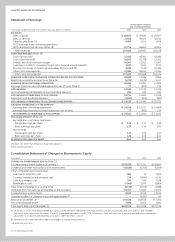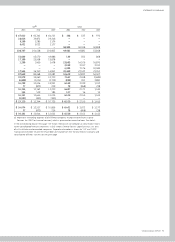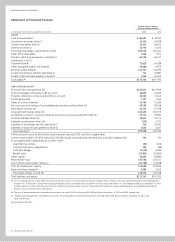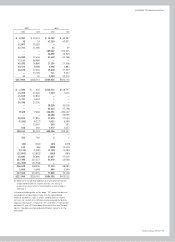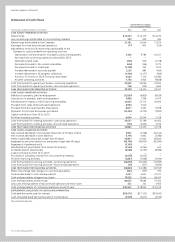GE 2011 Annual Report Download - page 66
Download and view the complete annual report
Please find page 66 of the 2011 GE annual report below. You can navigate through the pages in the report by either clicking on the pages listed below, or by using the keyword search tool below to find specific information within the annual report.’
64 GE 2011 ANNUAL REPORT
Critical Accounting Estimates
Accounting estimates and assumptions discussed in this section
are those that we consider to be the most critical to an under-
standing of our fi nancial statements because they involve
signifi cant judgments and uncertainties. Many of these estimates
include determining fair value. All of these estimates refl ect our
best judgment about current, and for some estimates future,
economic and market conditions and their effects based on
information available as of the date of these fi nancial statements.
If these conditions change from those expected, it is reasonably
possible that the judgments and estimates described below could
change, which may result in future impairments of investment
securities, goodwill, intangibles and long-lived assets, incremen-
tal losses on fi nancing receivables, increases in reserves for
contingencies, establishment of valuation allowances on deferred
tax assets and increased tax liabilities, among other effects. Also
see Note 1, Summary of Signifi cant Accounting Policies, which
discusses the signifi cant accounting policies that we have
selected from acceptable alternatives.
LOSSES ON FINANCING RECEIVABLES are recognized when they are
incurred, which requires us to make our best estimate of probable
losses inherent in the portfolio. The method for calculating the
best estimate of losses depends on the size, type and risk charac-
teristics of the related fi nancing receivable. Such an estimate
requires consideration of historical loss experience, adjusted for
current conditions, and judgments about the probable effects of
relevant observable data, including present economic conditions
such as delinquency rates, fi nancial health of specifi c customers
and market sectors, collateral values (including housing price
indices as applicable), and the present and expected future levels
of interest rates. The underlying assumptions, estimates and
assessments we use to provide for losses are updated periodi-
cally to refl ect our view of current conditions. Changes in such
estimates can signifi cantly affect the allowance and provision for
losses. It is possible that we will experience credit losses that are
different from our current estimates. Write-offs in both our con-
sumer and commercial portfolios can also refl ect both losses that
are incurred subsequent to the beginning of a fi scal year and
information becoming available during that fi scal year which may
identify further deterioration on exposures existing prior to the
beginning of that fi scal year, and for which reserves could not
have been previously recognized. Our risk management process
includes standards and policies for reviewing major risk expo-
sures and concentrations, and evaluates relevant data either for
individual loans or fi nancing leases, or on a portfolio basis,
as appropriate.
Further information is provided in the Global Risk Management
section and Financial Resources and Liquidity—Financing
Receivables sections, the Asset Impairment section that follows
and in Notes 1, 6 and 23.
REVENUE RECOGNITION ON LONG-TERM PRODUCT SERVICES
AGREEMENTS
requires estimates of profi ts over the multiple-year
terms of such agreements, considering factors such as the fre-
quency and extent of future monitoring, maintenance and
overhaul events; the amount of personnel, spare parts and other
resources required to perform the services; and future billing rate
and cost changes. We routinely review estimates under product
services agreements and regularly revise them to adjust for
changes in outlook. We also regularly assess customer credit risk
inherent in the carrying amounts of receivables and contract
costs and estimated earnings, including the risk that contractual
penalties may not be suffi cient to offset our accumulated invest-
ment in the event of customer termination. We gain insight into
future utilization and cost trends, as well as credit risk, through
our knowledge of the installed base of equipment and the close
interaction with our customers that comes with supplying critical
services and parts over extended periods. Revisions that affect a
product services agreement’s total estimated profi tability result
in an adjustment of earnings; such adjustments increased earn-
ings by $0.4 billion in 2011, decreased earnings by $0.2 billion in
2010 and increased earnings by $0.2 billion in 2009. We provide
for probable losses when they become evident.
Further information is provided in Notes 1 and 9.
ASSET IMPAIRMENT assessment involves various estimates and
assumptions as follows:
Investments. We regularly review investment securities for
impairment using both quantitative and qualitative criteria.
Effective April 1, 2009, the FASB amended ASC 320 and modifi ed
the requirements for recognizing and measuring other-than-
temporary impairment for debt securities. If we do not intend to
sell the security and it is not more likely than not that we will be
required to sell the security before recovery of our amortized
cost, we evaluate other qualitative criteria to determine whether
a credit loss exists, such as the fi nancial health of and specifi c
prospects for the issuer, including whether the issuer is in compli-
ance with the terms and covenants of the security. Quantitative
criteria include determining whether there has been an adverse
change in expected future cash fl ows. For equity securities, our
criteria include the length of time and magnitude of the amount
that each security is in an unrealized loss position. Our other-
than-temporary impairment reviews involve our fi nance, risk and
asset management functions as well as the portfolio manage-
ment and research capabilities of our internal and third-party
asset managers. See Note 1, which discusses the determination
of fair value of investment securities.
Further information about actual and potential impairment
losses is provided in the Financial Resources and Liquidity—
Investment Securities section and in Notes 1, 3 and 9.


